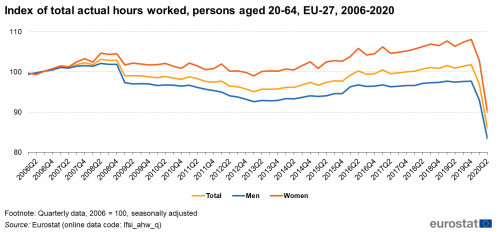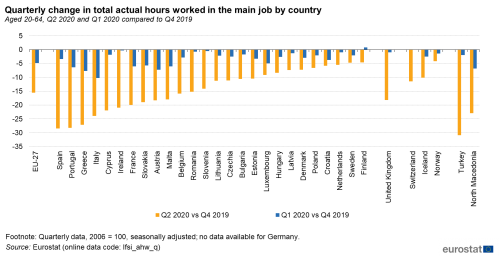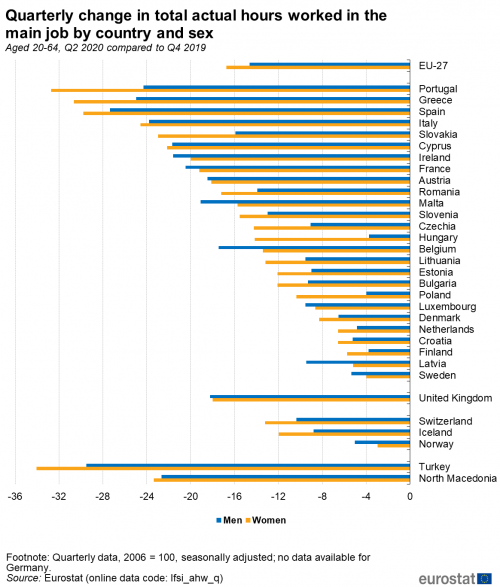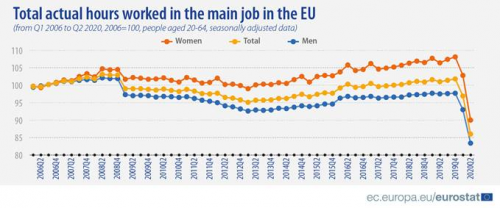Archive:Hours of work and absences from work - quarterly statistics
Data extracted in November 2020
Planned article update: January 2021
Highlights
During the first quarter of 2020, the labour market was affected by COVID-19 measures taken by Member States. Measures continued during the second quarter of the same year. Employment and unemployment, as defined by the ILO concept, are in this particular situation not sufficient to describe the developments taking place in the labour market, at least in the short term. Therefore, Eurostat was triggered to develop a set of additional seasonally adjusted quarterly indicators which should help to capture the most recent movements on the labour market in the 27 Member States of the European Union (EU).
The recently developed indicators include the total labour market slack, which comprises all persons who have an unmet need for employment either because they are unemployed according to the ILO definition, are close to unemployment while not fulfilling all ILO criteria, or are working part-time and would like to work additional hours. Furthermore, absences from work broken down by reason are published, as well as an index of total actual hours worked in the main job. Recent job leavers and starters, as well as weekly total absences and transitions out of employment, complete the set of recently developed indicators.
In this article, the focus is on the quarterly changes in the actual hours worked in the main job, using an index where the reference (100) is the year 2006. The index indicates the percentage of change in the total actual hours of work in the considered quarter of a year compared to the total actual working hours in 2006. The value of the index is influenced by the number of employed persons in the considered quarter of a year, as well as by the number of hours worked by each of these employed persons. Please note that the presented data is seasonally adjusted.
The aim of this article is to describe the actual hours of work in the European Union (EU) as a whole, for all EU Member States individually, as well as for the United Kingdom, three EFTA countries (Iceland, Norway and Switzerland) and two candidate countries (North Macedonia and Turkey).
The article is a part of the online publication Labour market in the light of the COVID-19 pandemic - quarterly statistics alongside, amongst others, the articles Labour market slack - unmet need for employment and Absences from work.
Full article
Sharp drop in the actual working hours at EU level continued in second quarter of 2020
Between the last quarter of 2019 and the second quarter of 2020, the index of total actual hours worked in the main job (computed using the year 2006 as reference with an index of 100 points) dropped sharply in the EU-27: from 101.8 index points to 86.0 index points (decrease of 15.8 index points) (Figure 1). Since the beginning of the time series (first quarter of 2006), the lowest level of the index can be found in the first quarter of 2013, with 95.1 index points (compared to 2006 it dropped by 4.5 index points). The second quarter of 2013 is a turning point from which the continuous decline, which was due to the financial and economic crisis of 2008, was followed by an increase in the actual working hours.

Source: Eurostat (lfsi_ahw_q)
Looking at the gender differences, women were hit harder than men by the COVID-19 crisis. The index of total actual working hours for the female population fell from 108.1 to 90.0 index points between the last quarter of 2019 and the second quarter of 2020 (decrease of 18.1 index points). For the male population, it dropped from 97.7 to 83.4 index points (decrease of 14.3 index points). Nevertheless, in the second quarter of 2020, the index of total actual hours worked is still higher for women (90.0 index points) than for men (83.4 index points). The values of the index recorded in the second quarter of 2020 (90.0 index points for women and 83.4 index points for men) mean that the total actual hours of work decreased both for women and men compared with 2006 (reference for the index) but that the decrease since 2006 is less pronounced for women. Nevertheless, the decrease since the start of the COVID-19 pandemic (fourth quarter of 2019) is stronger for women.
Impact on actual working hours at country level
The total actual working hours have been affected differently across countries since 2006. Different patterns can be observed (see Video 1).
Italy was the first European country hit by the COVID-19 pandemic and also the most impacted during the first three months of 2020. However, the situation changed during the second quarter of 2020, when Spain appeared to be affected the most. The difference in the total actual working hours between the fourth quarter of 2019 (2019Q4) and the second quarter of 2020 (2020Q2) is highly visible in this last country. The index of total actual hours worked in the main job decreased from 95.9 index points in 2019Q4 to 68.6 index points in 2020Q2 (decrease of 27.3 index points). As a comparison, the difference in actual working hours in Italy between 2019Q4 (99.3 index points) and 2020Q2 (75.5 index points) was 23.8 index points.
Women in Spain were profoundly affected by the COVID-19 crisis: the Spanish female population encountered a drop from 110.4 index points in 2019Q4 to 77.5 index points in 2020Q2 (decrease of 32.9 index points), while a fall from 87.4 to 63.5 index points (decrease of 23.9 index points) was registered for the Spanish male population over the same period. The financial and economic crisis of 2008 had a smaller impact on the actual working hours than the COVID-19 crisis in this Member State.
Similarly to Spain, Malta recorded a substantial decrease in the index of total actual hours worked between 2019Q4 and 2020Q2. The index of total actual hours worked decreased from 179.4 index points in 2019Q4 to 147.2 index points in 2020Q2 (decrease of 32.2 index points). Nevertheless, during the second quarter of 2020, this country still registered the highest index level among all EU Member States. Since 2006, the increase in actual working hours was exceptional for women, who doubled their working hours with an index of 203.4 points in the second quarter of 2020. The increase since 2006 for the male population was significantly smaller, going from 100.6 index points in 2006 to 127.0 index points in 2020Q2. Furthermore, men were less affected by the COVID-19 crisis than women in terms of hours worked: the male index moved from 157.0 points in 2019Q4 to 127.0 points in 2020Q2 (decrease of 30.0 index points) while the female index decreased from 241.4 points to 203.4 points (decrease of 38.0 index points) over the same period.
By contrast, Finland is the EU country with the smallest impact of the COVID-19 crisis on the hours worked: the index of actual working hours accounted for 99.5 points in 2019Q4 and for 94.9 points in 2020Q2 (decrease of 4.6 index points). Finnish women were more affected in terms of hours worked than their male counterparts. The index of actual hours worked decreased by 5.8 index points for women (101.3 points in 2019Q4, 95.5 points in 2020Q2) and by 3.7 points for men (98.0 points in 2019Q4, 94.3 points in 2020Q2).
In Bulgaria and Greece, the index of total hours worked in the main job was affected by the 2008 financial and economic crisis and was even more affected by the COVID-19 crisis (situation in 2020Q2). In Bulgaria, the index reached its highest level of 109.2 points in the first quarter of 2008 and its lowest level of 93.7 points in the fourth quarter of 2012 (difference of 15.5 index points). During the second quarter of 2020, the Bulgarian index reached his lowest level so far (89.7 index points). Before the COVID-19 crisis, the Greek index reached its lowest level in the fourth quarter of 2013, with 76.4 index points. The level was slightly higher in the first quarter of 2020, i.e. 78.5 points. Please note that in the last quarter of 2019 the index accounted for 85.1 index points. However, during the second quarter of 2020, the index dropped to a historically low value of 62.0 index points.
Focus on the quarterly changes
In this section, the change in the total actual working hours between the last quarter of 2019 and the second quarter of 2020 is analysed. This is done in terms of relative changes by taking the last quarter of 2019 as a reference. The percentage change (increase or decrease) between these two quarters is presented. In addition, in Figure 2, the quarterly change between the last quarter of 2019 and the first quarter of 2020 is also shown for comparison.
Spain is the most affected country in second quarter of 2020
All Member States, for which data is available, experienced a strong drop in the index of total actual hours worked in the main job in the first quarter of 2020 compared with the last quarter of 2019, with Finland being an exception. Taking the percentage of change between these two consecutive quarters (with last quarter of 2019 as reference), the highest decrease was observed in Italy (-10.3 %), followed by Greece (-7.8 %), Austria (-7.3 %) and Portugal (-6.4 %) (Figure 2). By contrast, Finland recorded an increase of +0.8 % in the index of the total volume of hours worked.

Source: Eurostat (lfsi_ahw_q)
For all countries the decline continued during the second quarter of 2020, albeit with a change in the hierarchy. During these three months (2020Q2), Spain (-28.5 %), Portugal (-28.2 %), Greece (-27.1 %) and Italy (-24.0 %) recorded the largest declines in the total actual hours worked (2019Q4 taken as a reference). By contrast, Finland and Sweden reported a reduction of less than 5 % (-4.6 % and -4.7 %).
Women hit the hardest
The change in the total actual hours worked in the main job between the fourth quarter of 2019 and the second quarter of 2020 is more visible at EU level for the female population than for the male population. Figure 3 shows a reduction of -16.7 % in the total actual hours worked for women compared with -14.6 % for men.
Among EU Member States, Portugal and Greece had their women the most affected in terms of total actual working hours in Q2 2020. They registered between 2019Q4 and 2020Q2 a decrease in their total working hours of -32.7 % and -30.7 % respectively. Portuguese and Greek men were also highly affected, with a respective decrease of -24.3 % and -25.0 % in their total working hours. However, in comparison with men in other EU Member States, Spanish men were hit the hardest, with a reduction of -27.3 % in their total actual working hours (for Spanish women the decrease was -29.8 %) between 2019Q4 and 2020Q2 .

Source: Eurostat (lfsi_ahw_q)
In Ireland, France, Austria, Malta, Belgium, Luxembourg, Latvia and Sweden, men registered a more noticeable decrease in their total working hours between 2019Q4 and the 2020Q2 than their female counterparts. The differences between men and women were most pronounced in Malta, Belgium and Latvia where the change for men was equal to -19.1 %, 17.4 % and -9.5 % respectively. For women, the decrease was less conspicuous with -15.7 %, -13.4 % and -5.2 % respectively.
Source data for tables and graphs
![]() Hours of work Q2 2020: Figures and tables
Hours of work Q2 2020: Figures and tables
![]() Hours of work Q2 2020: Figures and tables for video
Hours of work Q2 2020: Figures and tables for video![]()
Data sources
All figures in this article are based on seasonally adjusted quarterly results from European labour force survey (EU-LFS).
Source: The European Union Labour Force Survey (EU-LFS) is the largest European household sample survey providing quarterly and annual results on labour participation of people aged 15 and over as well as on persons outside the labour force. It covers residents in private households. Conscripts in military or community service are not included in the results. The EU-LFS is based on the same target populations and uses the same definitions in all countries, which means that the results are comparable between countries.
European aggregates: EU refers to the sum of EU-27 Member States.
Country note: Due to technical issues with the introduction of the new German system of integrated household surveys, including the Labour Force Survey (LFS), the figures for Germany for the first and second quarter of 2020 are not direct estimates from LFS microdata, but based on a larger sample including additional data from other integrated household surveys. A restricted set of indicators has been estimated and used for the production of the LFS Main Indicators. These estimates have also been used in the calculation of EU and EA aggregates, and are published for some selected indicators (estimates for Germany are flagged as p – provisional, and u – unreliable). For more information, see here.
Definitions: The concepts and definitions used in the Labour Force Survey follow the guidelines of the International Labour Organisation.
Five different articles on detailed technical and methodological information are linked from the overview page of the online publication EU Labour Force Survey.
Context
The COVID-19 crisis hit Europe in January and February 2020, with the first cases confirmed in Spain, France and Italy. COVID-19 infections have now been diagnosed in all European Union (EU) Member States. To fight the pandemic, EU Member States have taken a wide variety of measures. From the second week of March, most countries closed retail shops apart from supermarkets, pharmacies and banks. Bars, restaurants and hotels have also been closed. In Italy and Spain, non-essential production was stopped and several countries imposed regional or even national lock-down measures which further stifled the economic activities in many areas. In addition, schools were closed, public events were cancelled and private gatherings (with numbers of persons varying from 2 to 50) were banned in most Member States.
The large majority of the prevention measures were taken during mid-March 2020 and most of the prevention measures and restrictions were kept for the whole of April and May 2020. The first quarter 2020 is consequently the first quarter in which the labour market across the EU has been affected by COVID-19 measures taken by the Member States.
Employment and unemployment as defined by the ILO concept are, in this particular situation, not sufficient to describe the developments taking place in the labour market. In this first phase of the crisis, active measures to contain employment losses led to absences from work rather than dismissals, and individuals could not search for work or were not available due to the containment measures, thus not counting as unemployed.
Direct access to
<maintables>
Main tables
<maintables>
